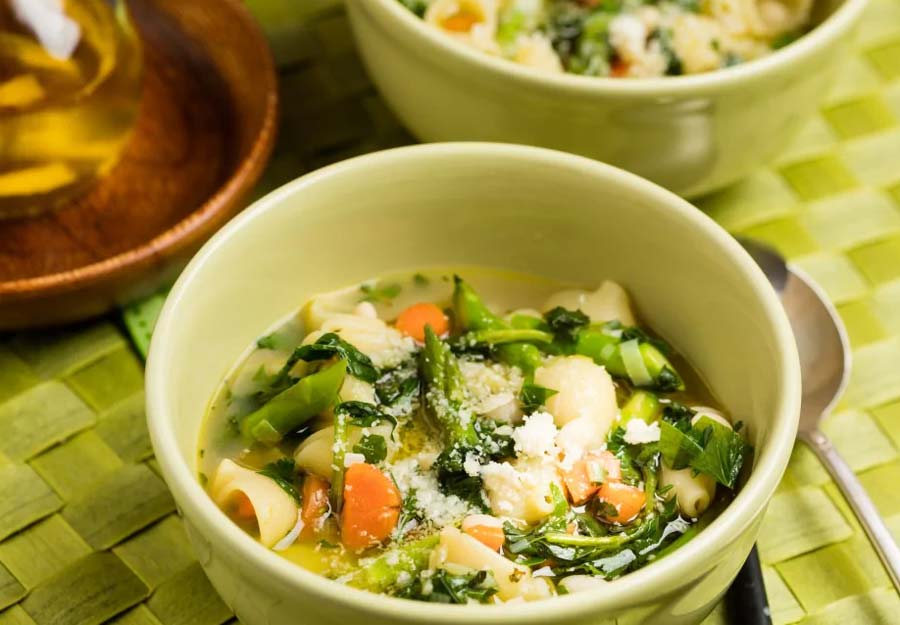 Goran Kosanovic for The Washington Post
Goran Kosanovic for The Washington Post
If you're using garlic scapes, add them shortly before serving, with the herbs.
Make Ahead: The beans need to be soaked for at least 8 hours and preferably overnight. They can be cooked, cooled and refrigerated in their liquid for 2 days before you proceed with the recipe.
(The beans may absorb more liquid the longer they are stored, so you may need to add more broth or water for the soup.)
The cooked minestrone will keep in the refrigerator for up to 4 days; if you plan to freeze this soup (for up to 1 month), do not add the pasta until the minestrone has been defrosted and reheated.
![]()
SPRING VEGETABLE MINESTRONE
SERVINGS: 4 (makes 7 to 8 cups)
If you're using garlic scapes, add them shortly before serving, with the herbs.
MAKE AHEAD: The beans need to be soaked for at least 8 hours and preferably overnight. They can be cooked, cooled and refrigerated in their liquid for 2 days before you proceed with the recipe. (The beans may absorb more liquid the longer they are stored, so you may need to add more broth or water for the soup.) The cooked minestrone will keep in the refrigerator for up to 4 days; if you plan to freeze this soup (for up to 1 month), do not add the pasta until the minestrone has been defrosted and reheated.
Ingredients
• 1 cup dried white or yellow beans, such as cannellini, lima or mayocoba, soaked for at least 8 hours and preferably overnight
• 8 cups water, or more as needed
• 2 bay leaves
• 3 tablespoons extra-virgin olive oil, plus more for garnish
• 1 3/4 teaspoons sea salt
• 2 medium leeks or 2 medium bulb spring onions, or a combination, white and light-green parts thinly sliced (if using spring onions, thinly slice the green tops and keep them separate)
• 2 to 4 stalks green garlic, white and light-green parts thinly sliced; may substitute 3 to 4 garlic scapes, cut on the diagonal into 1/2-inch pieces (may substitute 2 large cloves garlic, crushed)
• 2 to 3 medium carrots, scrubbed and chopped
• Leafy greens from 1 bunch (6 to 8 ounces) turnips, leaves separated from any tough stalks and chopped or torn into bite-size pieces (may use kale, collards, escarole or broccoli rabe)
• 6 ounces dried shaped pasta, such as orrecchiete or small shells
• 1/4 teaspoon freshly ground black pepper, or more as needed
• 6 ounces (1/2 bunch) slender asparagus (woody ends trimmed off), cut on the diagonal into 1-inch pieces
• 10 to 15 sprigs parsley, leaves and tender stems chopped
• 1 tablespoon marjoram leaves, chopped (optional)
• 1 ounce grated Parmigiano-Reggiano or pecorino Romano cheese, for garnish
Steps
Cover the soaked beans in a stockpot or large saucepan with the 8 cups of water. Add the bay leaves, 1 tablespoon of the oil and 1/4 teaspoon of the salt. Bring to a low boil over medium heat, then reduce the heat to medium-low; cover partially and cook for 40 minutes to 1 hour, occasionally stirring gently, until the beans are tender but not at all mushy. Remove from the heat, cover and let stand; the beans will continue to soften somewhat as they cool. Leave the beans in their cooking broth and do not drain. Discard the bay leaves.
Heat the remaining 2 tablespoons of oil in a large, heavy-bottomed pot or Dutch oven over medium heat. Once the oil shimmers, add the leeks and/or green onions (white and light-green parts), green garlic, carrots and 1/2 teaspoon of the salt. Cook for 7 to 8 minutes or just until the vegetables begin to soften.
Pour off enough of the cooling bean broth to measure a total of 6 cups; add 5 cups to the pot with the vegetables, then stir in the remaining teaspoon of salt. Reserve the remaining 1 cup to thin the soup later as needed. (If your beans have absorbed so much liquid that the yield is less than 6 cups, add or use water as needed.)
If the leafy greens you are using are mature and fibrous, add them at this point; cook for 5 minutes before adding the pasta. If the greens are relatively tender, stir in the pasta; once the liquid starts bubbling at the edges, add the greens. Some younger, very tender greens (turnips or radish tops, for example) will cook even more quickly, in which case, cook the pasta for about 5 minutes before adding the greens. Stir in the pepper.
When the pasta is 2 to 3 minutes from al dente, transfer the cooked beans to the pot. If you'd like a thinner soup, add the remaining cup of broth and/or water, as needed.
Add the asparagus; cook for 2 minutes, then add the spring onion tops, if using; garlic scapes, if using; parsley; and marjoram, if using. Turn off the heat, and allow to stand for a minute or two.
Ladle into bowls and garnish each portion with a drizzle of oil and sprinklings of pepper and/or grated cheese, if desired.
Nutrition | Per serving: 450 calories, 18 g protein, 71 g carbohydrates, 12 g fat, 2 g saturated fat, 0 mg cholesterol, 980 mg sodium, 14 g dietary fiber, 7 g sugar


 Contact The Editor
Contact The Editor
 Articles By This Author
Articles By This Author